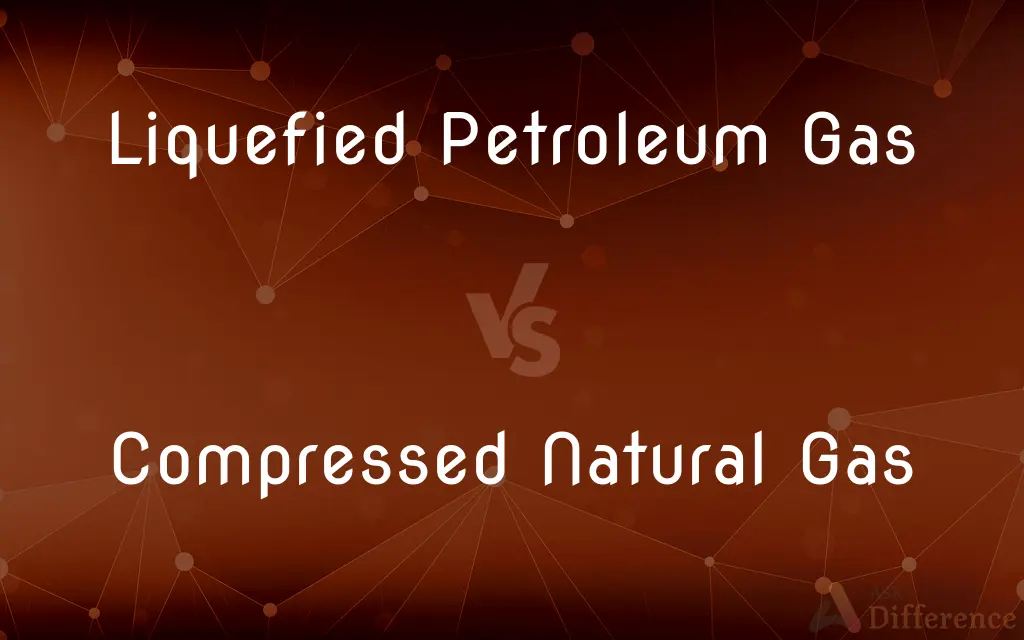Liquefied Petroleum Gas vs. Compressed Natural Gas — What's the Difference?
Edited by Tayyaba Rehman — By Fiza Rafique — Published on January 12, 2024
Liquefied Petroleum Gas (LPG) is stored as a liquid under pressure, while Compressed Natural Gas (CNG) is stored as gas at high pressure.

Difference Between Liquefied Petroleum Gas and Compressed Natural Gas
Table of Contents
ADVERTISEMENT
Key Differences
Liquefied Petroleum Gas, or LPG, is a blend primarily of propane and butane, stored under pressure as a liquid. It is widely used for cooking, heating, and as a fuel for certain vehicles. The process of liquefaction involves cooling or pressurizing, which reduces the volume of the gas, making it more efficient to store and transport.
Compressed Natural Gas, known as CNG, is mainly methane stored at high pressure in a gaseous state. CNG is used in vehicles and is becoming more popular as a cleaner alternative to traditional gasoline and diesel fuels. Unlike LPG, CNG is compressed rather than liquefied, which requires a different type of storage tank and infrastructure.
The energy content of Liquefied Petroleum Gas is higher than that of Compressed Natural Gas, meaning that LPG can deliver more energy by volume compared to CNG. This makes LPG a preferred choice in situations where storage space is limited or energy density is important, such as portable cooking equipment or rural heating solutions.
Storage requirements for LPG and CNG also differ. LPG can be stored in relatively lightweight and low-pressure tanks, while CNG requires heavy-duty, high-pressure cylinders. The difference in storage methods affects the cost and convenience of installing and maintaining the necessary infrastructure for each type of gas.
Safety considerations for Liquefied Petroleum Gas and Compressed Natural Gas vary due to their physical properties. LPG's heavier-than-air nature means it can pool at ground level, posing a risk of ignition, while CNG, being lighter than air, disperses quickly if leaked, reducing the risk of flammability.
ADVERTISEMENT
Comparison Chart
State at Room Temperature
Stored as liquid under pressure.
Stored as gas at high pressure.
Primary Components
Propane and butane.
Methane.
Energy Content
Higher energy content by volume.
Lower energy content by volume.
Storage Tanks
Lower-pressure, lighter tanks.
High-pressure, heavier tanks.
Safety
Can pool at ground level.
Disperses quickly into the air.
Compare with Definitions
Liquefied Petroleum Gas
LPG is a versatile energy source for heating and cooking.
Liquefied petroleum gas is popular in off-grid homes for heating.
Compressed Natural Gas
CNG is often used as a fuel in buses and trucks.
The bus fleet has been upgraded to use compressed natural gas for cleaner emissions.
Liquefied Petroleum Gas
LPG is used as a portable, clean-burning fuel gas.
Our camping stove runs efficiently on liquefied petroleum gas.
Compressed Natural Gas
CNG is stored under high pressure.
Compressed natural gas tanks must withstand high pressures.
Liquefied Petroleum Gas
LPG can be easily transported as a liquid.
Tanks of liquefied petroleum gas were delivered to the remote village.
Compressed Natural Gas
CNG serves as an alternative to gasoline.
The switch to compressed natural gas vehicles reduces dependence on oil.
Liquefied Petroleum Gas
LPG consists mainly of propane and butane.
Liquefied petroleum gas is a hydrocarbon mixture with a variety of uses.
Compressed Natural Gas
CNG is primarily composed of methane.
Compressed natural gas is mostly methane, which burns cleanly.
Liquefied Petroleum Gas
LPG is also used as a cleaner alternative vehicle fuel.
Many taxis in the city have been converted to run on liquefied petroleum gas.
Compressed Natural Gas
CNG is known for being a clean-burning fuel.
Cities prefer compressed natural gas for public transport due to its low pollution levels.
Common Curiosities
What is Compressed Natural Gas used for?
CNG is primarily used as a fuel for vehicles and for domestic heating in some cases.
How is Liquefied Petroleum Gas stored?
LPG is stored in pressurized tanks as a liquid.
What is Liquefied Petroleum Gas used for?
LPG is used for cooking, heating, hot water, and vehicle fuel.
Is Liquefied Petroleum Gas environmentally friendly?
LPG burns cleaner than gasoline but is still a fossil fuel with associated emissions.
What are the economic benefits of Compressed Natural Gas?
CNG can be cost-effective due to lower fuel prices and maintenance costs.
What are the economic benefits of Liquefied Petroleum Gas?
LPG is often cheaper than gasoline and diesel, offering cost savings over time.
Is Liquefied Petroleum Gas more energy-dense than Compressed Natural Gas?
Yes, LPG has a higher energy density than CNG.
How is Compressed Natural Gas stored?
CNG is stored in high-pressure cylinders as a gas.
What are the safety concerns with Compressed Natural Gas?
The primary safety concerns with CNG involve tank integrity due to its high storage pressure.
What are the safety concerns with Liquefied Petroleum Gas?
LPG can cause fires or explosions if leaks occur and it's exposed to an ignition source.
Can Liquefied Petroleum Gas be used in any vehicle?
Only vehicles equipped with an LPG conversion kit can use it as fuel.
Is Compressed Natural Gas renewable?
CNG itself is not renewable, but it can be produced from biogas, which is renewable.
Is Compressed Natural Gas environmentally friendly?
CNG is one of the cleanest burning fossil fuels, emitting less pollutants compared to other vehicle fuels.
Can Compressed Natural Gas be used in any vehicle?
Similar to LPG, only vehicles designed for CNG use or with a conversion kit can use CNG as fuel.
Is Liquefied Petroleum Gas renewable?
No, LPG is not renewable; it is produced from fossil fuels.
Share Your Discovery

Previous Comparison
Milk vs. Soy Milk
Next Comparison
Batch Fermentation vs. Continuous FermentationAuthor Spotlight
Written by
Fiza RafiqueFiza Rafique is a skilled content writer at AskDifference.com, where she meticulously refines and enhances written pieces. Drawing from her vast editorial expertise, Fiza ensures clarity, accuracy, and precision in every article. Passionate about language, she continually seeks to elevate the quality of content for readers worldwide.
Edited by
Tayyaba RehmanTayyaba Rehman is a distinguished writer, currently serving as a primary contributor to askdifference.com. As a researcher in semantics and etymology, Tayyaba's passion for the complexity of languages and their distinctions has found a perfect home on the platform. Tayyaba delves into the intricacies of language, distinguishing between commonly confused words and phrases, thereby providing clarity for readers worldwide.
















































